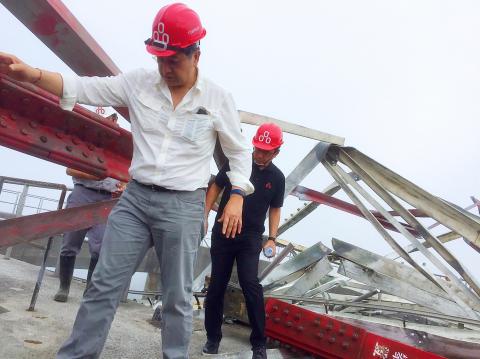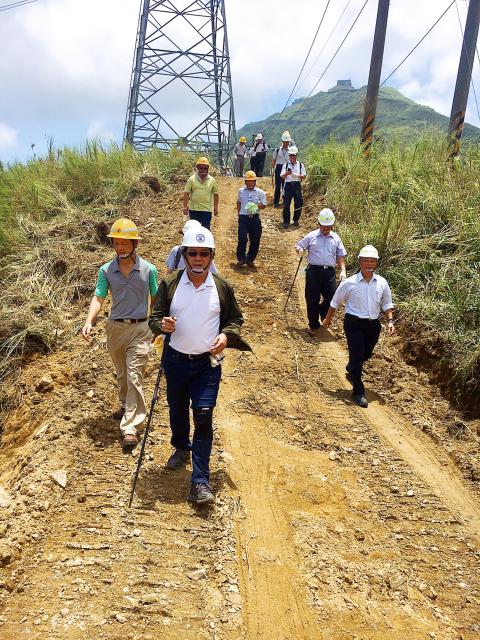State-run Taiwan Power Co (Taipower, 台電) is to increase the number of electrical circuits on transmission towers to improve the durability of the nation’s power grid, Minister of Economic Affairs Lee Chih-kung (李世光) said yesterday.
The improvement is part of a slew of measures being taken to protect the nation’s power facilities from natural disasters, he said.
“The power grid’s exposure risk is greater than that of power plants during natural disasters... We have asked Taipower to propose improvement plans,” Lee told reporters before the Ministry of Economic Affair’s weekly meeting.

Photo courtesy of Taiwan Cement Corp
The majority of the power supply warnings issued by Taipower since the 921 Earthquake in 1999 were caused by disruptions to the power grid rather than problems with power generaton, Lee said.
Almost all of the transmission towers in the nation are equipped with one electrical circuit each, which makes the power grid vulnerable to external forces, Taipower said.
The company has yet to decide whether to add electrical circuits to all towers or select a few areas to improve the power grid, as the plan involves a large investment, Lee said.

Photo courtesy of the Ministry of Economic Affairs
Adding new circuits to high-voltage towers might require personnel to work in the mountains and traverse national parks, which adds to operational difficulties, he added.
Increasing the electricity contribution from renewable sources is one of several measures to spread risk, as “green” energy facilities supply power to a smaller number of users in a designated area, which makes the power grid more resilient as transmission lines are shorter, Lee said.
The ministry’s priority is to restore the power supply from the privately-run Ho-Ping Power Co (和平電力), after a transmission tower in Yilan County collapsed on Saturday due to severe weather brought by Typhoon Nesat, Lee said.
The ministry aims to enhance the power transmission infrastructure there, he said.
Taipower finished building temporary power lines yesterday and sent equipment to the Dongao (東澳) area to repair the tower, Lee said, adding that the company would build a double-circuit temporary transmission tower instead of a single-circuit tower.
Ho-Ping Power is inspecting the condition of the power generators at the plant, as they might have been damaged when power transmission was abruptly cut while they were working at full capacity, Vice Minister of Economic Affairs Yang Wei-fu (楊偉甫) said.
The ministry estimates that Ho-Ping Power will resume electricity generation on Sunday next week at the earliest, Yang said.
The power plant generates 1.3 million kilowatts, or about 4 percent of the nation’s operating reserve margin. It mainly supplies power to northern Taiwan.
The nation’s operating reserve margin is estimated to drop to 4.43 percent today, which means power supply remains tight, Taipower data showed.
The margin is expected to fall to 2.41 percent on Wednesday and Thursday, meaning it will be lower than 900,000 kilowatts, Taipower said.

CHIP RACE: Three years of overbroad export controls drove foreign competitors to pursue their own AI chips, and ‘cost US taxpayers billions of dollars,’ Nvidia said China has figured out the US strategy for allowing it to buy Nvidia Corp’s H200s and is rejecting the artificial intelligence (AI) chip in favor of domestically developed semiconductors, White House AI adviser David Sacks said, citing news reports. US President Donald Trump on Monday said that he would allow shipments of Nvidia’s H200 chips to China, part of an administration effort backed by Sacks to challenge Chinese tech champions such as Huawei Technologies Co (華為) by bringing US competition to their home market. On Friday, Sacks signaled that he was uncertain about whether that approach would work. “They’re rejecting our chips,” Sacks

NATIONAL SECURITY: Intel’s testing of ACM tools despite US government control ‘highlights egregious gaps in US technology protection policies,’ a former official said Chipmaker Intel Corp has tested chipmaking tools this year from a toolmaker with deep roots in China and two overseas units that were targeted by US sanctions, according to two sources with direct knowledge of the matter. Intel, which fended off calls for its CEO’s resignation from US President Donald Trump in August over his alleged ties to China, got the tools from ACM Research Inc, a Fremont, California-based producer of chipmaking equipment. Two of ACM’s units, based in Shanghai and South Korea, were among a number of firms barred last year from receiving US technology over claims they have

It is challenging to build infrastructure in much of Europe. Constrained budgets and polarized politics tend to undermine long-term projects, forcing officials to react to emergencies rather than plan for the future. Not in Austria. Today, the country is to officially open its Koralmbahn tunnel, the 5.9 billion euro (US$6.9 billion) centerpiece of a groundbreaking new railway that will eventually run from Poland’s Baltic coast to the Adriatic Sea, transforming travel within Austria and positioning the Alpine nation at the forefront of logistics in Europe. “It is Austria’s biggest socio-economic experiment in over a century,” said Eric Kirschner, an economist at Graz-based Joanneum

OPTION: Uber said it could provide higher pay for batch trips, if incentives for batching is not removed entirely, as the latter would force it to pass on the costs to consumers Uber Technologies Inc yesterday warned that proposed restrictions on batching orders and minimum wages could prompt a NT$20 delivery fee increase in Taiwan, as lower efficiency would drive up costs. Uber CEO Dara Khosrowshahi made the remarks yesterday during his visit to Taiwan. He is on a multileg trip to the region, which includes stops in South Korea and Japan. His visit coincided the release last month of the Ministry of Labor’s draft bill on the delivery sector, which aims to safeguard delivery workers’ rights and improve their welfare. The ministry set the minimum pay for local food delivery drivers at